wrestling / Columns
The Magnificent Seven: The Top 7 WWE Face Authority Figures
From the late 1990s on, the device of having a heel authority has dominated mainstream American wrestling. These dastardly masterminds stack the deck against our heroes, open shows with lengthy promos about their latest machinations, and tend to be at their most entertaining when they’re getting their comeuppance—falling out power, taking a beatdown, or watching as their best laid plans crumble.
But then there’s the other side of the coin. Wrestling has seen fewer, and shorter-lived face authority figures, in part because it makes less sense as a storytelling convention to have faces stack the odds against heels and in part because, well, it’s just different—less easy to repeat or replicate for lack of examples to work from.
There have, nonetheless, been a number of face authority figures who have succeeded. Consider Nick Bockwinkel and JJ Dillon’s perfectly reasonable runs atop WCW or Dusty Rhodes or Sting running TNA. Some of these figures worked on account of using face charisma to rally support behind faces who were actively performing in the ring. Some of them worked by behaving in a genuinely neutral fashion, and thus adding a sense of legitimacy to the in-ring proceedings.
WWE has seen its share of face authority figures—often short-lived, but in a select few cases, quite memorable. So, this week, I’m taking a look back at WWE’s top seven face authority figures.
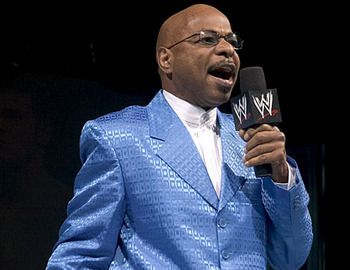
#7. Teddy Long
Tedddy Long gets the nod for this countdown in large part due to longevity. For the better part of a decade, Long was the default GM for WWE’s Smackdown brand (in addition to a stint at the head of ECW). While his best-remembered qualities may include over-use of the term “player” and booking any conceivable multi-man confrontation into a tag match, he also got to hand down some pretty important decisions, like reinstating Rey Mysterio’s place in the WrestleMania 22 World Heavyweight Championship match after Randy Orton stole the opportunity from him, introducing the “New Talent Initiative” that would introduce names like Bobby Lashley and Mr. Kennedy to the WWE fans. Long was also the face of Smackdown in a well-handled Raw vs. Smackdown program that built to Survivor Series 2005.
While many of the names on this list got an extra boost of ethos on account of their in-ring credentials leading up to their time in charge, Long garnered credibility for near-opposite reasons. While he had previously worked as a manager and referee, Long got more face time on a national stage when he took over as GM and that became his signature role. Thus, he had relatively few personal rivalries to inform his work as GM (or to undermine his believability by ignoring past animosities). Long was the type of authority figure who seemed on the up and up, only favoring the good guys to the extent that a reasonably logical, objective person would. Thus, he was a perfectly inoffensive man in charge who didn’t distract from the in-ring product, but rather enhanced it by providing a grounding force to justify the match-making of his era.
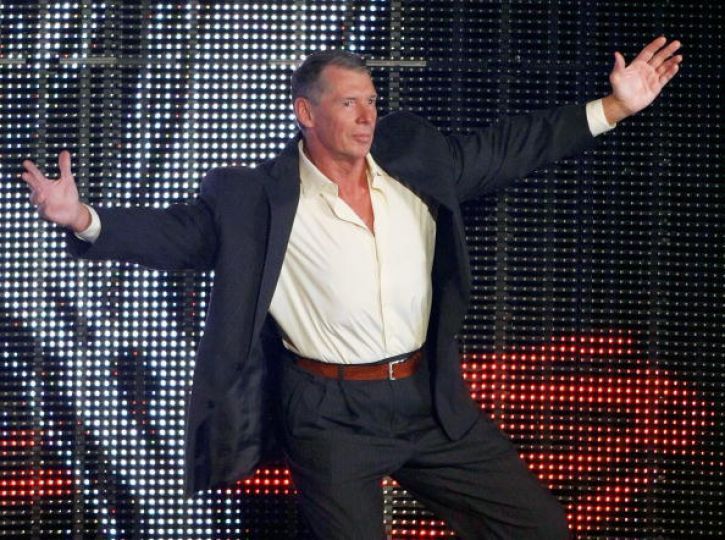
#6. Vince McMahon
I was tempted to rate Vince McMahon much higher on this countdown because, frankly, I’ve found just about all of his character work from the dawn of the Attitude Era onward entertaining. That said, McMahon was missing a particular trustworthy quality that should really define a face character—as reasonable as he was in the good guy role, I also had the sense that, when I watched him, I was always waiting for the other shoe to drop on his eventual heel turn.
But while he lasted as face, McMahon performed with the swagger of a man who really was in charge, as well as the put-on rage that he always played so well. McMahon was fed up when he aligned himself with The Union, he was the righteously indignant father figure when Triple H dared steal away his daughter, and he has had all of the gravitas of God himself when he’s made cameo appearances in recent years to give lesser authority figures a taste of justice for growing too big for their britches—pressuring Vickie Guerrero to do the right thing, or putting The Authority’s power on the line in the build to Survivor Series 2014. You can never quite trust the Vince McMahon character, but even as a good guy, he tends to be a lot of fun on screen.

#5. Stephanie McMahon
Like her father, Stephanie McMahon is best known and arguably better at her heel work, in her case with The Authority, The McMahon-Helmesley regime, The Alliance, and a handful of other key periods. But in the middle of all of this activity, McMahon had a memorable run from 2002 to 2003 as the GM of Smackdown, during which time she was quite purely a face. During this time, she antagonized Raw’s heel GM Eric Bischoff and in storyline brought Hulk Hogan back into action. The story arc led to her father picking a fight with her, culminating in, to date, the only Father-Daughter I Quit Match—a brutal little piece of business that ended up far more entertaining than it really had any right to be.
The core of McMahon’s character in this era was that of an independent businesswoman. She was strong, refused to be intimidated by Biscoff and refused to be bullied by her father, and was ultimately willing to engage in a match that she had little chance of winning, in order to stand up for her principles. Unlike most of her father’s work as a face, this was not a case of someone acting like a face to set up a heel angle down the line, but rather a great, off-beat bit of stand-alone character work, in a rare instance when a WWE authority figure could actually be perceived as a reasonable role model for viewers.
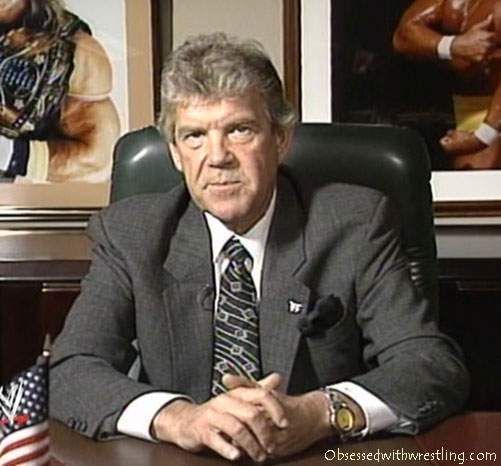
#4. Jack Tunney
I grew up in the era of Jack Tunney as president of WWF. Tunney generally maintained a neutral face-heel alignment, but given the proclivity of absolutely power to corrupt absolutely in the wrestling world, I’m prepared to advocate for him as a de facto face.
Tunney, more than any other authority figure in WWF or WWE history, maintained a dignity about his position. In a period when the WWF was still kind of-sort of trying to pass itself off as a legitimate sporting organization, he was the diplomatic, consistently professional figure to hand down major rulings, book major matches, and function as the law and order of the WWF.
Moreover, Tunney represents a certain ideal that seems to have been lost when it comes to authority figures. No, he didn’t actually do much—to my knowledge, he was a Canadian promoter who took a figurehead role when he sold out to Vince McMahon, and went to do very little of consequence behind the scenes, and scarcely became involved in on-air storylines in a particularly meaningful way. But therein lies the beauty of the character. That he could step in to cast a ruling when Ted Dibiase tried to buy the WWF Championship, when Hulk Hogan and The Undertaker traded the world title via dubious means, or when Lex Luger and Bret Hart eliminated each other simultaneously at the end of the 1994 Royal Rumble. Just the same, he was not a presence who needed to deliver fifteen minute promos to kick off TV shows, or get embroiled in scandalous affairs. He was an authority figure to the extent the WWF needed one and otherwise left the spotlight to the WWF Superstars.
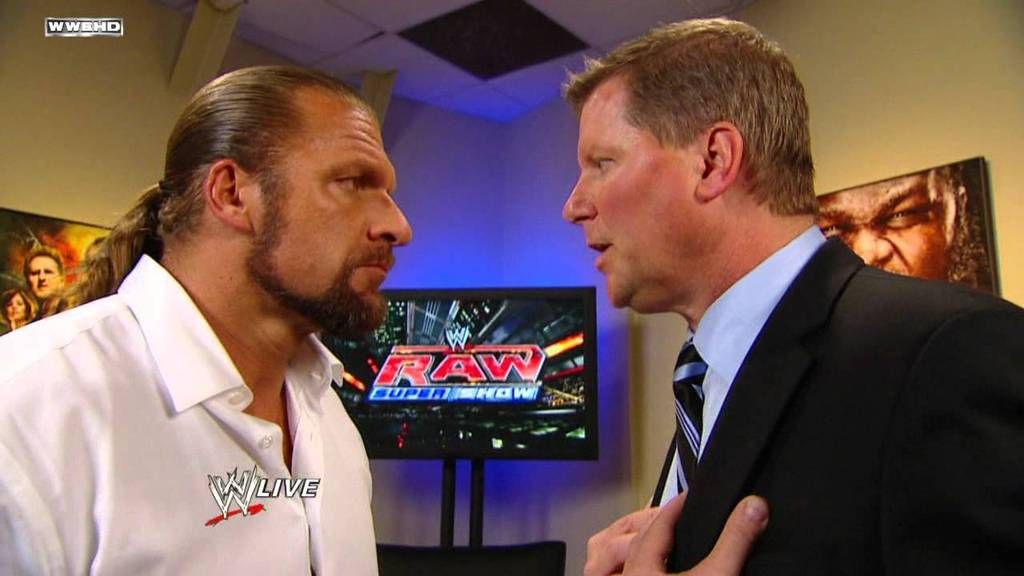
#3. Triple H
Triple H has flirted with the face-heel line a number of times, and his “cool heel” act has raised some eyebrows about whether we’re really supposed to understand him to be a villain at all. But in this case, I’m looking less at the lack of focus in Triple H’s character and more at a period of time in the summer and fall of 2011 when Triple H ran Raw as WWE’s Chief Operating Officer.
A number of folks are bitter about this run in Triple H’s career because it coincided with CM Punk positively catching fire and WWE squandering so much of his heat—temporarily keeping him away from the WWE Championshipn and even having him drop a PPV match to semi-retired Triple H. I get those criticisms, and won’t claim that WWE’s booking at the time was anywhere near perfect. Just the same, I found the Triple H character particularly fascinating in that era. He took the reins of Raw in a conflicted state—supplanting his father-in-law, who the board of directors had deemed unfit to continue running the show. He went on to oversee a tumultuous period during which CM Punk ran off with the WWE Championship and then came back again, and during which The Miz and R-Truth launched an underrated vigilante angle in which they were determined to ruin things for everyone else. Best of all, the period saw the return of Kevin Nash as not only a heel, but a force to tempt Triple H back to his old villainous ways, and create shades of gray when he claimed that Trips had asked him to attack Punk.
During this period, Triple H marked a unique blend of a credible, physical force, mixed with the overwhelming task of his first on-air management job, overseeing a particularly wild time, and struggling the harness the respect of the locker room and balance old personal friendships with an internal impulse to do the right thing. He was brilliantly conflicted and my main complaint about this era is that WWE didn’t ride it out long enough. The roster walked out on Trips, leaving him only himself, John Cena, Sheamus, and Punk to entertain the fans for an off-beat opening to one episode of Raw. I was interested to see where the promotion may have taken that storyline next—only for Vince McMahon to bring the angle full circle and announce that the board was removing Triple H from his position running Raw as well, and plugging in John Laurinaitis.
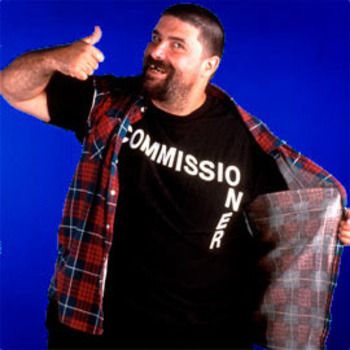
#2. Mick Foley
Mick Foley continues a pattern that you may have detected for a goodly portion of this list: his reign as a face authority figure was much shorter than it should have been.
Just the same, for a good chunk of 2000 and a brief stint in 2001, Foley played the role of Commissioner. It was a good way of keeping his personality a part of WWE programming while his body got a much deserved break from regular in-ring performance. Moreover, as an authority figure, Foley had the credentials of a grizzled veteran and major star without projecting any unnecessary gravitas. In stark contrast to the McMahon family members and characters that followed their template, Foley was good-natured and made light of the absurdities of his role, setting up his office in broom closets, and using his position to poke fun at some of the heels of the day. Better yet, during his 2001 run Foley provided a voice for the people in booking title unification matches for Survivors Series to eliminate some of the clutter of WWF and WCW championships co-existing at the time.
In the grand scheme of things, Foley probably didn’t contribute enough drama to the on-air product to justify his position of authority. Just the same, he was one of the most entertaining men in charge that WWE has ever seen.
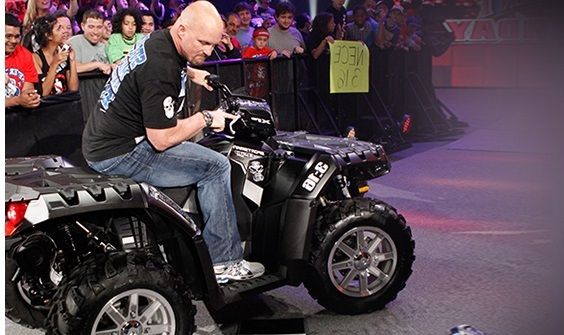
#1. Steve Austin
The post-Attitude Era Raw found itself in a tricky spot. The brand extension spread out the talent pool. The Rock left for Hollywood. Mick Foley was done as a full-time in-ring performer. And is if all that wasn’t enough, Steve Austin’s injuries caught up to him and he was forced to retire.
While this period was not an altogether great one for the Raw brand, one of the few bright spots was Austin’s continued presence on the show, first sharing GM duties with Eric Bischoff, and then taking on the title of sherriff—a role so silly that I’d argue only someone with Stone Cold’s cred could pull it off. Austin blasted heels and then persevered through the wacky stipulation that he was only allowed engage with people who physically engaged him first. This period saw the build to a classic Survivor Series showdown in which Austin and Bischoff each selected teams to represent them with the winner taking full control of a Raw. Later, as Sherriff, Austin rode his ATV to ringside and created havoc anew.
Unfortunately, Austin’s time in power came to an abrupt close due to political differences (the general consensus seems to be that when he was going to be booked to lose to Jonathan Coachman in an undercard match, he preferred to walk away altogether). Just the same, for the time it lasted, Austin offered both comedy and a face authority figure that the fans genuinely cared about. Austin’s tenure buoyed the Raw brand during a difficult time and added a different chapter Stone Cold’s already vaunted legacy.
Who were your favorite face authority figures who missed the cut? Linda McMahon? Gorilla Monsoon? Roddy Piper? Ric Flair? Bret Hart? Shawn Michaels? AJ Lee? Let us know what you think in the comments section.
Read more from Mike Chin at miketchin.com and follow him on Twitter @miketchin.







